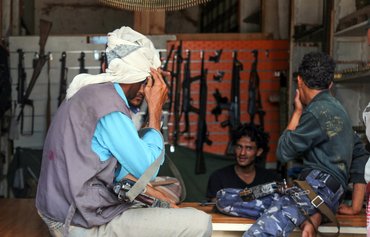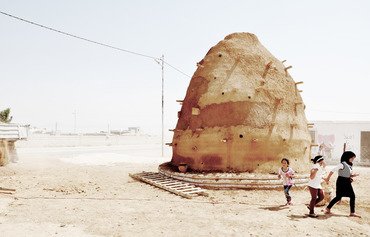Yemen's ongoing war has adversely affected the maawaz manufacturing industry, merchants and weavers of the traditional garment tell Al-Mashareq.
The maawaz, a handicraft distinct to Yemen, is a traditional wrap-around garment that differs by region and has been worn by men for generations.
Weavers of the traditional garment have faced numerous challenges and set-backs, including a lack of government support and the suspension of donor aid.
"Maawaz weaving is a profession that requires high craftsmanship, and we continue to practice it amid low demand and competition from similar imported products," maawaz weaver Hani Qassem told Al-Mashareq.
"Yemeni maawaz are as varied as the Yemeni areas [in which they are worn], however the Baida, Hadramaut and Lahj varieties were the most famous, popular and in highest demand before the war," Qassem said.
These days, he said, "the country's preoccupation with the war and living circumstances have forced people to focus their attention on obtaining food".
Producing a Baida-style maawaz takes up to two days, and it fetches prices ranging from 15,000 Yemeni riyals ($60) to 50,000 riyals ($200), he said.
"The Hadramaut-style maawaz ranks second, and takes less time to produce than the Baida-style maawaz," Qassem said.
As for the Lahj-style maawaz, he added, "it is possible to weave two of them a day and so its price is more agreeable to customers, and thus these are in highest demand in provinces where the traditional maawaz is widely worn".
These include the provinces of Aden, Lahj, Abyan and Shabwa, Taez, Ibb, al-Hodeidah, among others, he said.
Ebbing demand for maawaz
The economic impact of Yemen's war has forced numerous enterprises to suspend their operations, shop-owner Ishaq al-Saeedi told Al-Mashareq.
Hundreds of workers have been laid off, and the suspension of government salaries has negatively affected people's purchasing power, he said, which has led to lower demand by customers for all products, including clothing.
"The demand for hand-woven maawaz has dropped to less than half of what it was before the war," he said, noting that the cost of thread used in the weaving process also has more than doubled compared to the pre-war period.
Al-Saeedi said demand for traditional maawaz increases during the holy month of Ramadan and the period preceding Eid al-Adha, at which time the purchase of clothing in general tends to increase.
"But Baida-style and Hadramaut-style maawaz are in less demand during that period due to their high prices," he said.
Traditional maawaz are of high quality, he said, noting that in coastal provinces such as Hadramaut and Abyan, they are soaked in seawater to soften the material.
Lack of government support
"The lack of attention given to crafts enterprises by the Ministry of Culture and donors was one of the reasons for the decline in the production of high-quality traditional handicrafts," al-Saeedi said.
"There are still women's associations specialised in handicrafts to support and sponsor families that produce such handicrafts that are tied to Yemen's heritage," said Fayza al-Suleimani, Small and Micro Enterprise Promotion Service (SMEPS) public relations and media official.
While these associations operate in many provinces, there has been a decline in interest in traditional crafts, such as maawaz weaving, she told Al-Mashareq.
"I think the most important reason is that the craftsmen lack marketing skills to sell their products," she said, noting that many sell them to wholesalers at meager prices, which has prevented some from taking up this profession.
"Another reason is the weak role of craft associations in supporting this industry and opening up high-quality markets for young craftsmen," Suleimani said.
An absence of government agencies that foster the craft sector has compounded this situation, she added, noting that for their part the weavers have not organised and formed trade associations.
Donor support programmes are currently concentrating on emergency programmes due to the war, she said.
Suleimani suggested "providing support in the future to craft associations that sponsor maawaz weaving and market craftsmen's work" and helping them to continue their operations, even amid conflict and challenges.

![A Yemeni craftsman weaves a Lahj-style maawaz inside his sewing workshop in Sanaa. [Faisal Darem/Al-Mashareq]](/cnmi_am/images/2018/05/18/12688-Yemen-Sanaa-shop-600_384.jpg)






The most important obstacles to this craft are: First, the presence of the Chinese machine in Yemen which produces 100 Mawaz a day at a low price. This is in addition to the import of Chinese Mawaz. However, the latter is less harmful than the former. Second: The lack of government support because of the war and corruption and the lack of associations that pay attention to this craft.
Reply1 Comment(s)